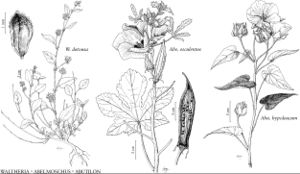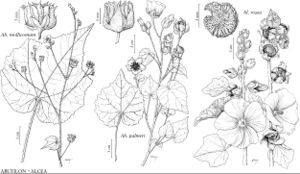Abutilon
Gard. Dict. Abr. ed. 4, vol. 1. 1754.
| Taxon | Illustrator ⠉ | |
|---|---|---|
 | Waltheria detonsa Abelmoschus esculentus Abutilon hypoleucum | Linny Heagy Linny Heagy Linny Heagy |
 | Abutilon mollicomum Abutilon palmeri Alcea rosea | Linny Heagy Linny Heagy Linny Heagy |
Subshrubs, shrubs, or herbs. Stems erect, sometimes trailing (A. parvulum) or procumbent or ascending (A. wrightii), glabrescent or pubescent, sometimes viscid (A. hirtum, A. reventum, A. trisulcatum). Leaves: stipules usually persistent, subulate, lanceolate, or filiform; blade elliptic, ovate, [cordiform], sometimes shallowly lobed, but not maplelike [sometimes umbellate]; involucel absent. Flowers: calyx not accrescent (except A. hulseanum, A. hypoleucum, A. palmeri, and A. wrightii), not inflated, not completely enclosing fruit, lobes not ribbed, lanceolate, ovate, cordate, or acuminate; corolla usually yellow or orange, less often pinkish, sometimes with dark red center; staminal column included or exserted; ovules 3 (–6) per carpel; style 5–25-branched; stigmas sometimes black, capitate. Fruits schizocarps, erect, not inflated, globose, ovoid, oblate, cask-shaped, or cylindric, usually not indurate, variably hairy but not setose; mericarps 5–25, 1-celled follicle, adherent to adjacent mericarps and persistent on their axes, without dorsal spur, apex usually acute or acuminate to spinescent, sometimes rounded or obtuse, abaxially dehiscent. Seeds usually 3–6 per mericarp, usually turbinate, puberulent or scabridulous. x = 7, 8.
Distribution
United States, Mexico, West Indies, Central America, South America, Asia, Africa, Australia
Discussion
Species ca. 160 (18 in the flora).
Abutilon is mostly tropical and subtropical with relatively few species reaching into fully temperate climates.
The South American native Abutilon megapotamicum (A. Sprengel) A. Saint-Hilaire & Naudin (= A. vexillarium E. Morren) is sometimes grown as a basket plant in colder regions and perhaps in the open in frost-free areas; it is not naturalized in the flora area. Another South American species, A. striatum Dickson ex Lindley [= A. pictum (Gillies ex Hooker) Walpers], has been widely introduced elsewhere as an ornamental and is naturalized in some tropical countries. This species is grown in North American gardens as a perennial in warmer climates and an annual in colder ones, but is not known to be naturalized in the flora area. Abutilon indicum (Linnaeus) Sweet has been said to be naturalized in southern Florida (L. H. Bailey et al. 1976); its occurrence in the flora area has not been substantiated. This species has an Indo-Australian origin (J. van Borssum Waalkes 1966) and is naturalized in the West Indies. Abutilon grandifolium (Willdenow) Sweet is sometimes cultivated and may escape.
Outside North America, plants of Abutilon may be arborescent, and their corollas may be of other colors although yellow or yellow-orange predominates.
Selected References
Lower Taxa
Key
| 1 | Styles 5-branched | > 2 |
| 1 | Styles 6–25-branched | > 6 |
| 2 | Stems trailing; leaf blades sparsely pubescent, surface visible; flowers solitary; petals pinkish, without dark center. | Abutilon parvulum |
| 3 | Calyces 5–8 mm; corollas rotate, petals 9–15 mm, yellow, without dark center; leaf blade margins sharply serrate | > 4 |
| 3 | Calyces 3–5 mm; corollas often reflexed, petals 4–6 mm, yellow or pink, often with dark center; leaf blade margins irregularly crenate-serrate | > 5 |
| 4 | Calyces 5–6 mm, lobes fully reflexed in fruit; petals 10–15 mm; inflorescences open panicles or solitary flowers. | Abutilon coahuilae |
| 4 | Calyces 6–8 mm, lobes erect in fruit; petals 9–15 mm; inflorescences compact panicles. | Abutilon malacum |
| 5 | Young stems terete, minutely tomentulose; fruits cask-shaped, not medially constricted | Abutilon incanum |
| 5 | Young stems 3-sulcate, often viscid in inflorescence; fruits subcylindric, medially constricted. | Abutilon trisulcatum |
| 6 | Stems pubescent and with simple hairs 2–5 mm | > 7 |
| 7 | Stems viscid; corollas orange-yellow with dark red center; styles 20–25-branched | Abutilon hirtum |
| 7 | Stems not viscid; corollas pale yellow or yellow-orange without red center; styles 6–12-branched | > 8 |
| 8 | Petals 20 mm, yellowish, fading pinkish; seeds 4–6 per mericarp | Abutilon hulseanum |
| 8 | Petals 5–12 mm, yellowish or yellow-orange, not fading pinkish; seeds 3 per mericarp | > 9 |
| 9 | Leaf blades 10–20 cm; inflorescences paniculate; petals 5–8 mm; styles 8–10-branched. | Abutilon mollicomum |
| 9 | Leaf blades 2.5–6.5 cm; inflorescences solitary flowers; petals 8–12 mm; styles 6–8-branched. | Abutilon parishii |
| 10 | Apices of mericarps spinose. | Abutilon theophrasti |
| 10 | Apices of mericarps not spinose (obtuse, rounded, acute, acuminate, or apiculate) | > 11 |
| 11 | Plants procumbent or ascending, to 0.5 m; leaf blades 1.5–4 cm, ± as long as wide, markedly discolorous; styles 6–9-branched. | Abutilon wrightii |
| 11 | Plants erect, 0.5–2 m; leaf blades 2–12(–20) cm, often longer than wide, concolorous or discolorous; styles 6–15-branched | > 12 |
| 12 | Styles 13–15-branched; calyx lobes broadly cordate, often 8–20+ mm wide, accrescent in fruit. | Abutilon hypoleucum |
| 12 | Styles 6–12-branched; calyx lobes cordate, lanceolate-ovate, or acuminate, to 8 mm wide, little if at all accrescent | > 13 |
| 13 | Calyces 3–6 mm | > 14 |
| 13 | Calyces 8–15(–20) mm | > 15 |
| 14 | Styles 6–9-branched; mericarp apices acute or apiculate; stems stellate-tomentulose; leaf blades ± concolorous. | Abutilon fruticosum |
| 14 | Styles 10-branched; mericarp apices rounded or obtuse; stems minutely glandular-pubescent to glabrate; leaf blades strongly discolorous. | Abutilon reventum |
| 15 | Leaf blades roughly pubescent; styles 8–10-branched | > 16 |
| 15 | Leaf blades softly tomentose; styles 10–12-branched | > 17 |
| 16 | Stems without glandular hairs; seeds reticulately scabridulous; calyx basally truncate. | Abutilon abutiloides |
| 16 | Stems with glandular and stellate hairs intermixed; seeds uniformly puberulent; calyx basally cuneate. | Abutilon berlandieri |
| 17 | Leaf blades ± as wide as long; petals 20–25 mm; stems stellate-pubescent and sometimes with simple hairs 1–2 mm. | Abutilon palmeri |
| 17 | Leaf blades ca. 2 times as long as wide; petals 10–18 mm; stems stellate-pubescent. | Abutilon permolle |